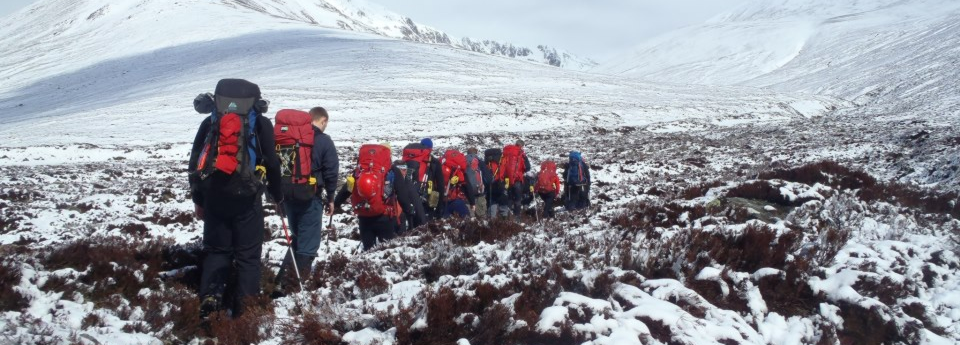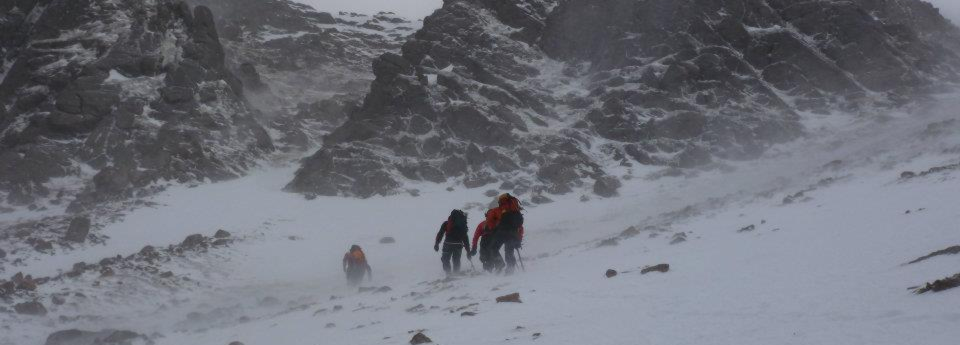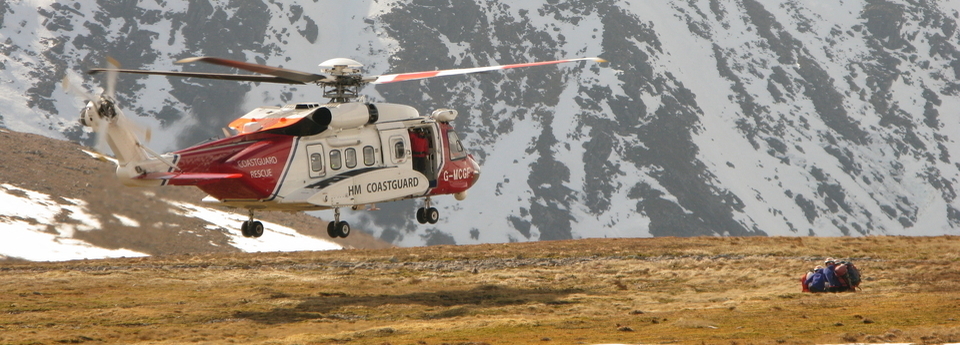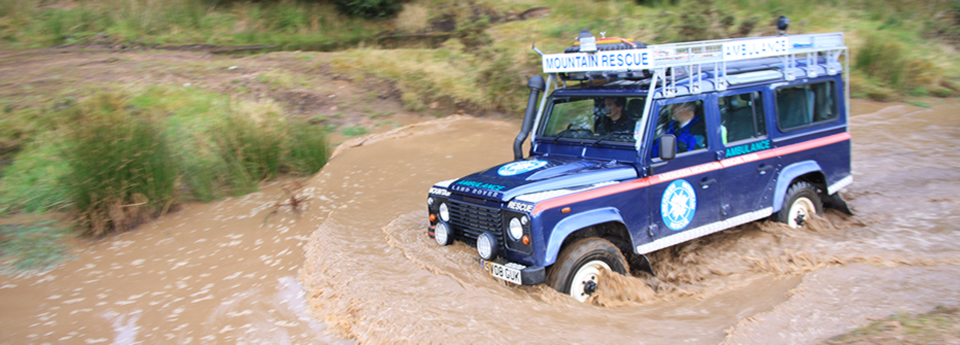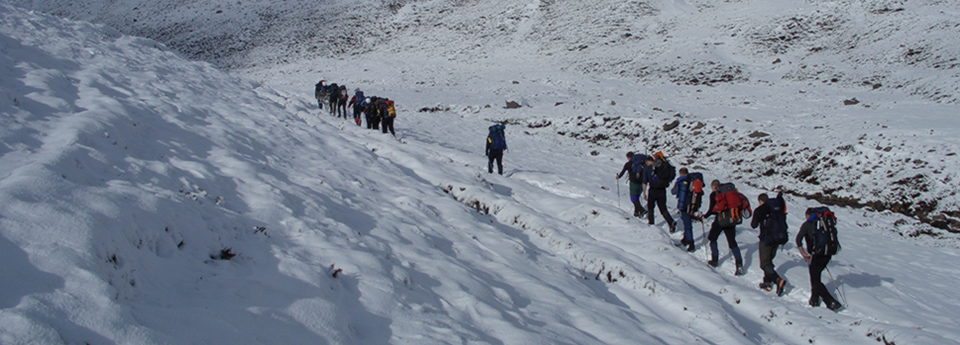Team Leader's Report 2011
Highlights of 2011
2011 proved to be another interesting year for the Team with a variety of callouts involving both mountain and non mountain incidents.
Mountain related incidents have almost exclusively been in relation to individuals who have been reported overdue, or where the missing person themselves have contacted the Police requesting assistance. In many instances this continues to highlight issues related to poor navigation and planning skills - many people still lack the basic skills to navigate in the mountains safely in poor weather conditions.
In the course of 2011 the Team undertook a number of lectures and talks designed to provide information and support for local hillwalking clubs and organisations on safe travel in the Scottish hills. These have been generally very well received and have helped to raise the profile of the Team in our local area.
The prolonged and snowy winter of 2010-2011saw some very significant snowfall in the Cairngorms and indeed there were many weeks at the beginning of the winter when access to the hills was a problem. This of course meant that many walkers were also denied access and this may have accounted for a lower than normal number of callouts over the winter.
Team membership has stabilised at thirty-four and we are fortunate in that we have managed to attract to the Team a number of relatively young members who have brought with them considerable enthusiasm and energy.
The Team continues to benefit from a good mix of experience, and we now have a number of Team members who have completed in excess of twenty years in the Team. This combined with the influx of new Team members, places us in a very healthy position and bodes well for the future development of the Team
Throughout the year the Team has continued its programme of training and the combination of Thursday evening sessions and Team weekends has helped to provide the basis for a very productive year and one in which they overall skill level of the Team has been significantly enhanced. All Team members underwent a revalidation of their First Aid qualifications in October and we have also had running throughout the later part of the year a programme of driver training and assessment for all Team members who might be called upon to drive Team vehicles.
Back in the day
Well they do say that all good things must eventually come to an end and so it is with my tenure as Team Leader of Aberdeen Mountain Rescue Team. In Late January 2012 I will be stepping down from the post of Team Leader - a post I have held for the last nineteen years; 2012 will also see me complete forty-two years of service with Aberdeen Mountain Rescue Team, an organisation I joined at the tender age of seventeen.
Forty plus years is a long time to do anything, but I can honestly say that it has been a blast, and in the course of my time in the Team I have had the privilege to get to know and work with many fine people.
The last forty years have seen huge changes in both the organisation and development of Scottish Mountain Rescue, however as I reflect back on my time in mountain rescue I think that the thing that strikes me most is that fact that we still have the capacity to deploy highly professional and dedicated teams of individuals in a search and rescue role utilising peoples willingness to simply volunteer.
Like many things in life my introduction to mountain rescue was more by accident than design. In 1970 I found myself working for the Standard Life Insurance Company in Aberdeen and one of my work colleagues, who was a member of the Team, on hearing about my interest in the hills suggested that I come along to one of Aberdeen Mountain Rescue Team’s Thursday evening training sessions. Somewhat apprehensive I made my way on the following Thursday to the Team’s base, which at that time was located in the garages at the back of St John’s Hospital in Albyn Lane.
Now in those days one of the main sources of funding for the Team was the collection, bundling and selling on of newspapers for recycling. And so my first few Thursdays were spent in a very dusty garage tying up newspapers and listening quietly in the corner to the robust banter that passed between Team members – not for the faint hearted! My first real memory of anything that looked like proper mountain rescue training came when I was “invited” to put on a climbing waist belt, no fancy harnesses in those days, and try to arrest a falling leader. To be honest I wasn’t quite sure what a “falling leader” was and to my surprise it turned out to be a fifty-six pound weight tied to one end of a climbing rope and thrown out of a tree over a branch – the idea being that this would simulate the effect of having to stop the fall of a fellow climber. Now by the time this fifty-six pound weight had fallen ten feet it exerted a significant upward force which in turn lifted me off the ground and left me gasping for breath as the ill fitting climbing belt rose up round my chest and tried to squeeze my lungs up and out through my throat. It is worth pointing out that I was connected to the lower trunk of the tree by another length of climbing rope and so whilst slowing strangling suspend between heaven and earth the then Team Leader, Bill Marshall, attempted to instruct me in the finer points of belaying! This introduction to one of the key skills of rock climbing did not it would have to be said leave me feeling confident, particularly when it was pointed out that the next stage in the training was to do the same thing again but this time with two fifty-six pound weights on the end of the rope – the argument being of course that in terms of stopping the fall of a climber from above you this was a more realistic weight to have to arrest.
Thursday evening “training” was an interesting introduction to the Team but did not in anyway prepare me for my first Team Weekend. The Team had, and indeed still has, two centres of operation in the Cairngorms – one at the Spittal of Muick and one at Derry. I went on my first Team weekend with little knowledge of what to expect, no induction programme in those days or information sheet detailing what gear to take. So I turned up on the Friday night at the garage ill equipped both mentally and physically for what turned into a very demanding weekend. I was “taken” for a walk by a couple of Team members and within a very short distance I realised I was seriously out of my depth – the speed they moved at shocked me and the weekend was lost in a haze of sweat, fatigue and blisters. Going home on the Sunday night I vowed not to return – I struggled to see the fun in this. However, time is a great healer and two weekends later I was back, blisters almost healed and bit better prepared for what was to come.
And so Team weekends became something of a challenge – physically in terms of getting fit and being able to equal the pace set by the established Team members on the hill, and also mentally in learning to deal with the endless banter and ribbing that were a very significant feature of every weekend. Looking back I am amazed that I kept coming back for more – a lack of imagination may have something to do with it. As the youngest member of the Team at the time I was frequently the butt of jokes and japes and there was a tradition in the Team at the time of throwing folk in the Derry burn – something I experienced on numerous occasions. There was never any rhyme or reason to this – you would be sitting having a well earned cup of tea after a day on the hill when several Team members would grab arms and legs and you would be dragged from the bothy and tossed into the river.
In the early seventies there was no shortage of callouts and during my first few winters with the Team I found myself in the Corrie of Lochnagar and on the Ben Macdui plateau on a number of occasions. In those days the gear we used was quite primitive and a night spent in bad weather searching high in the Cairngorms was a significant challenge. Being cold and wet was, it seemed, part of the job and before the advent of breathable fabrics waterproofs were in reality little more than glorified plastic bags. Following a particular chilly callout in January 1974 which had us hanging about Corie Sputan Dearg for most of the night I was advised that I should purchase a down filled duvet jacket. In my somewhat impoverished state as student at the time this was a financial challenge too far. However, at that time Bill Marshall the Team Leader ran a climbing shop on George Street, in reality this consisted of several filing cabinets filled with various bits of equipment in the basement of his father in laws shop. I negotiated a deal with Bill which saw me as the proud owner of a bright red top of the range Gaston Rebuffat down filled duvet jacket costing £15 – Bill allowing me to pay it off at £5 a month. That jacket was a life saver and lived in my rucksack for the next twenty years. I still have it although it would be fair to say that the down has long since lost its loft.
The Team was and indeed continues to be quite a competitive organisation, speed and endurance on the hill has always been something of a badge of honour, and I realised early in my mountain rescue career that getting fit was something to be taken seriously. So I started running and what began as a means of just improving my fitness for the hill quickly became something of an obsession. Now back in the early 1970’s it was quite unusual to see people “out for a run”, indeed people regularly stopped and stared as I ran past them on the North Deeside Road, and being chased and occasionally set upon by dogs became something of an occupational hazard. Running did however have the desired effect and slowly but surely I started to put pressure on my fellow Team members on the hill. Being able to do more than just hold my own on the hill physically, perhaps more than anything boosted both my standing in the organisation and my self confidence.
In November 1971 the Aberdeen Team was involved in a callout for a party of six school children and two instructors who went missing during a blizzard on the Cairngorm Plateau whilst trying to reach the Feith Buidhe Hut. This was my first really big callout and as we headed up towards Corrie Etchachan in deep snow and poor weather conditions I was more than a little apprehensive. Breaking trail through thigh deep snow was a killer and by the time we got to the Hutchison Hut we were all feeling the strain. Radio communications back then were at best somewhat uncertain and as we prepared to head up towards Loch Etchachan we caught part of a transmission indicating that the party had been located. We realised that it would take many hours for us to gain the plateau given the weather conditions and we slowly made our way back towards Derry. What of course we did not know until much later was that although the party had indeed been located, five of the children and one of the instructors had died of exposure. This callout became known as the “Cairngorm Disaster” for that is what it was, and I very well remember the feelings of disbelief when we discovered later what the outcome had been. A week after the incident I along with several members of the Team visited the site of the incident on the plateau in what could only be described as benign conditions and retrieved some of the personal items left behind in the rush to evacuate the victims.
In 1976 I was elected to the post of Deputy Team Leader, I was twenty-three years old and was into my running and mountaineering with a vengeance. Although my early days in the Team had been challenging I was fortunate in that a number of seasoned Team members had been willing and able to give me the time and help to develop my mountaineering and rescue skills. Leading parties on the hill during callouts was both a challenge and a thrill and I never lost the feeling of nervous excitement when heading out into the hills at night and in poor weather conditions to search for a missing walker or climber.
Through the seventies and eighties there were many memorable callouts and it seemed to be a time when more and more folk were getting interested in the hills and also getting into difficulty. This period also saw a change in the composition of the Team with an increasing number of Team members being drawn from the rapidly developing oil and oil service industry; we also had by the early eighties quite a few teachers within the ranks of the Team. Prior to this time and certainly when I joined the Team in 1970 the vast majority of Team members worked locally as tradesmen or in the numerous local paper mills that existed in and around the Aberdeen area at the time. It is probably fair to say that the change in employment opportunities that came with the oil industry also changed the nature of the Team to some extent and perhaps some of the “rough edges” were knocked off.
Some of the most memorable callouts in the Cairngorms took place in the nineties and indeed it was about this time that the media began to take a very serious interest in the work of Scottish Mountain Rescue Teams. In February 1994 an extended search operation took place in the Cairngorms for a woman who went missing whilst out walking with some friends. The woman had become separated from the rest of the party and when she failed to turn up at the end of the day a massive search began covering a large area of the central Cairngorms and involving over one hundred and sixty team members from five different rescue Teams. Two days later she was found much to everyone’s surprise safe and well having survived two nights out in the open. This particular episode ended with a bit of controversy when the woman sold her survival story to the press and claimed that she would be donating some of the money to the Teams that had been involved in the search – the press followed this up only to discover that none of the Teams had received any money. Interestingly this incident was the forerunner to a number of extended searches which took place both in the Cairngorms and elsewhere for walkers who were “missing” for a number of days before turning up safe and well.
More recently the Team has been involved in a number of high profile incidents the most spectacular of which was almost certainly the search in late March 2001 for two USAF F15 fighter jets which went missing over the central Cairngorms. When the aircraft failed to return to their base and it became apparent that they must have crashed somewhere in the Ben Macdui area, a huge search operation was launched. In poor and deteriorating weather conditions I led a party from the Aberdeen Team up from Loch Etchacan towards the summit of Macdui. Visibility was very limited but as we approached the summit the first thing we were aware of was the very strong smell of aviation fuel quickly followed by large amounts of small debris fragments spread out in all directions over the snow. In rapidly deteriorating weather conditions we began to find larger parts of what was obviously the wreckage of at least one of the aircraft. As we were working our way through the wreckage one of the Team members spotted something billowing in the wind and when we went to investigate we found the body of one of the pilots. There was something very surreal about the whole experience, and as we made our way off the hill dragging the body of the pilot wrapped in what I think was part of a parachute a thoughtful silence settled on the group.
Rescue Teams train for callouts and in many ways they are the glue that holds the Team together. When the conditions are bad and the outcome unknown there is no doubt that the senses are sharpened and the challenge of undertaking a successful search or evacuation of a casualty can for a short period of time become all consuming and maybe even put one’s life into perspective. Over my years in the Team the adventures have been many, the laughs frequent and through it all has been the friendship and camaraderie of the guys in the Team. This is the sort of life experience that money can’t buy! I have enjoyed pretty much every minute of it and I regard it as having been both an honour and a privilege to have been a member of the Team and to have led it for the last nineteen years.
Mario Di Maio
Team Leader
